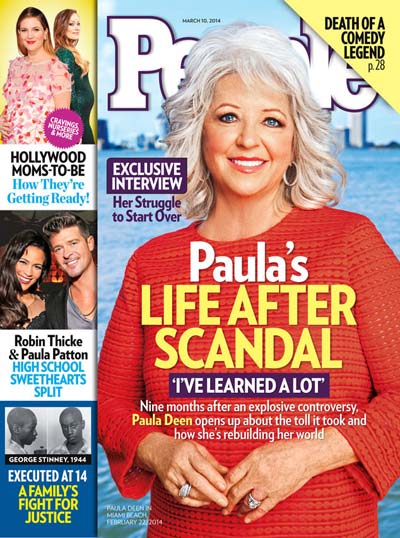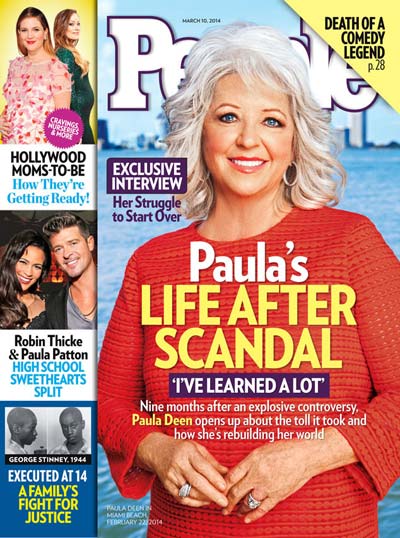 Paula Deen and George Stinney share the February 22, 2014 cover of People. (Image: ©Time Inc.)Also see: Truthout Interviews Bethania Palma Markus on Racism in the Media
Paula Deen and George Stinney share the February 22, 2014 cover of People. (Image: ©Time Inc.)Also see: Truthout Interviews Bethania Palma Markus on Racism in the Media
A recent ‘People’ magazine cover sparks consideration of the hiding-in-plain-sight but never-discussed racism that characterizes the United States and the ways US media subtly sustain that racism.
The cover of the February 22, 2014, edition of People magazine features a telling representation of the status of race relations in this country.
It features Southern chef Paula Deen promising a story about how she’s “rebuilding her world” and “hoping for a rebirth.” On the bottom left of the cover, there is the infamous mug shot of George Stinney, the Southern black child who was tried, convicted and executed in South Carolina in a murder trial that has since been called the equivalent of a lynching. At 14, he was the youngest person executed by the state in the 20th century.
Of course, the magazine didn’t acknowledge the irony of placing the two in the same edition or the way in which the stories overlap. Longtime journalist and author Thandisizwe Chimurenga said this instance is hardly isolated, and she pointed to long-standing biases and insidious contradictions in the way the media handles whites versus blacks.
“George Stinney’s case . . . is a very sad and tragic one,” Chimurenga noted. “It is also a story that is overrun with white supremacist complicity.” People magazine, in its own complicity, described Deen’s words and actions leading to her downfall as a “scandal,” as opposed to identifying them as part and parcel to the systemic racism responsible for the horrifying death of Stinney.
Deen, a white Southern woman, had admitted in a deposition to using the N-word and that she fantasized about a plantation-style wedding reception. She was also accused by a black former employee of using racial slurs, paying black employees less than whites, telling black employees to ring dinner bells and wear “Aunt Jemima” clothing. The kind of racism Deen displayed is rooted deep in the Jim Crow South.
After two white girls were murdered in 1944, Stinney was quickly arrested and charged, his family chased out of town by angry white mobs. In custody, he had no access to his parents and – despite the lack of physical evidence – was quickly convicted. He was too little to fit in the electric chair, and in the grisly scene, he was somehow disfigured by flames, as his family reported burying his burned remains.
While Deen enjoys a multimillion-dollar “comeback,” Stinney’s now-elderly siblings seek only to clear the child’s name.
Aside from the gross insensitivity of juxtaposing the two stories and the questionable editorial decision to give Deen precedence over Stinney and his family, the People cover seems emblematic of the brutal dishonesty and contrived ignorance about racism that pervades dominant media discourse in the United States.
Sometimes, as in the Central Park Jogger case of 1989, the modern media can contribute to the same kind of racially charged, feverish frenzy that surrounded Stinney. In that case, five teens – four black and one Latino – were convicted of raping and beating a white woman in Central Park. The media dubbed them the “wolf pack” and coined the term “wilding” to describe their alleged deeds. But in 2002, after serving their full sentences, all of the men were cleared by a court of any wrongdoing, with little media notice.
Other times, it’s more subtle but just as damaging.
“Remember that picture of the white couple who ‘found’ food during the flooding of Hurricane Katrina and the young Black man who had ‘looted’ a store?” Chimurenga asked, referring to an infamous pair of photos by Agence France-Presse and the Associated Press, respectively, which featured the couple and young man in almost identical circumstances – chest-deep in water dragging food, with captions that described the man as “looting” and the white couple “finding” food.
Chimurenga also pointed out disparities in the media’s handling of the recent, tragic shooting death of John Winkler, an aspiring producer who was white, versus the reportage on unarmed men of color who are shot by police. Winkler was killed by Los Angeles County Sheriff’s deputies who misidentified him as the aggressor in a hostage situation.
“Every media outlet that I’ve seen report on (the Winkler) story has used the word ‘mistake’ or ‘accident’ in the headline and the lede,” she said. “The concept of unintentional killing, of a ‘mistake’ or ‘accident’ is being reinforced, drummed into people. But I have yet to see numerous headlines and ledes using the words ‘mistake’ or ‘accident’ when a young Black man is shot in the back while running away from police; while holding his cellphone or his wallet or with his hands raised in the air.”
The effects are devastating, even if they aren’t immediately obvious to those impacted.
Multiracial TV programs, newscasts and even the composition of the White House residence and presidential cabinet belie continuing, even worsening, de facto racial inequality in which Americans of color are racially profiled, disproportionately incarcerated and suffer more poverty, unemployment, education inequality and foreclosure.
But while discussion of these issues is gaining steam, People magazine is still far from alone in tripping over the contradictions between reality and a topic they don’t want to deal with. The Washington Post conservative columnist Jennifer Rubin said last year that Americans should “not be held prisoner forever in a past that most Americans have never personally experienced. And I think it is time to stop using (race and racism) both as a crutch or as a method of stirring up (Obama’s) base.”
Perhaps Rubin should read the publication she writes for, The Post, reporting on a Brandeis University study that contradicted her:
A long-term examination of the financial lives of black and white Americans revealed that African Americans typically face a subtle but persistent opportunity gap that has served to widen financial disparities remaining from a long history of overt discrimination, according to a report to be released Wednesday by Brandeis University’s Institute on Assets and Social Policy.
Behind the income gap lie inequalities in wealth attained via access to real estate ownership and higher-paying jobs, according to the report. This is due to historical and continuing racism, including factors such as blacks having been disproportionately targeted for subprime mortgage loans.
Thus the idea that racism is used by people of color as a “crutch” in the face of an ongoing institutional racism is as troubling as the phenomenon described by a Tufts University study in which whites in the United States now see themselves as the main victims of racism at the hands of African Americans.
Sometimes the bias is in what the media doesn’t report.
After the Boston Marathon bombing last year garnered a constant barrage of 24-hour news coverage, David Dennis wondered in The Guardian why a deadly shooting spree at a Mother’s Day parade in New Orleans a couple months later didn’t get the same level of coverage and points out that the New Orleans shooting affected mostly “inner city,” working-class people of color. He wrote:
Deaths and mayhem anywhere are tragic. That should always be the case. The story here is where American tragedies don’t occur. American tragedies don’t occur on the southside of Chicago or the New Orleans 9th Ward. They don’t occur where inner city high school kids shoot into school buses or someone shoots at a 10-year old’s birthday party in New Orleans. Or Gary, Indiana. Or Compton. Or Newport News. These are where the forgotten tragedies happen and the cities are left to persevere on their own.
Problem Driven by Media
“In my experience and observation, mainstream media treat people of color, especially those of African descent, as criminals, suspects, or as having some kind of character defect when they are victims of crime, and whites tend to receive sympathy and be painted as completely innocent,” Chimurenga observed. “Sometimes it’s blatant and sometimes it’s subtle, but since antiblack bias is so pervasive in this society, subtlety is just as powerful as that which is blatant.”
Criminalization by the media creates an environment that permits the killing of blacks in the name of “self-defense,” by law enforcement or otherwise, she noted.
There is no government database on the number of people shot by police in the United States, but the activist group Malcolm X Grassroots Movement compiled media reports from 2012 and counted 313 deaths of black people at the hands of police, security guards or vigilantes that year – or one every 28 hours. Its tally included the shooting death of Trayvon Martin, the unarmed Florida teenager who was followed and shot dead by neighborhood watchman George Zimmerman. Martin’s death pushed racism in the United States to the forefront of consciousness, with even President Obama weighing in.
But while the right-wing blog and media juggernaut wasted no time digging through Martin’s past for proof of criminality, less obvious forms of bias make their way into mainstream news reporting daily, Chimurenga said.
“Mainstream media gives credence, too much credence, to ‘authority’ figures – government officials and law enforcement,” she said. “In too many ways, media carries their water for them. There is not enough basic skepticism or digging for deeper context and meaning. Many times, media is both cheerleader and megaphone for police terror in how they report on crime.”
When police shoot a black man, often the first question reporters will ask is whether the victim had any “gang ties,” she pointed out.
The problem is so pronounced and frequent that Los Angeles’ Youth Justice Coalition has demanded that law enforcement no longer identify the victim of an officer-involved shooting as a “gang member” until they have found that to be unquestionably the case.
“Not only can that be false, but also re-criminalizes a person after death” when they never had a trial, said Emilio Lacques-Zapien of the Youth Justice Coalition. Lacques-Zapien gave the example of 22-year-old Deangelo Lopez, who was shot and killed by LA County sheriff’s deputies last year.
“They said he’s a gang member who has a criminal history; he has tattoos – all these things that criminalize him,” Lacques-Zapien said. “He’s dead, and his family is still trying to figure out what happened.”
Hopefully they won’t have to wait as long as Stinney’s family has had to for a resolution.
Matching Opportunity Extended: Please support Truthout today!
Our end-of-year fundraiser is over, but our donation matching opportunity has been extended! All donations to Truthout will be matched dollar for dollar for a limited time.
Your one-time gift today will be matched immediately. Your monthly donation will be matched for the whole first year, doubling your impact.
This matching gift comes at a critical time. As Trump attempts to silence dissenting voices and oppositional nonprofits, reader support is our best defense against the right-wing agenda.
Help Truthout confront Trump’s fascism in 2026, and have your donation matched now!
